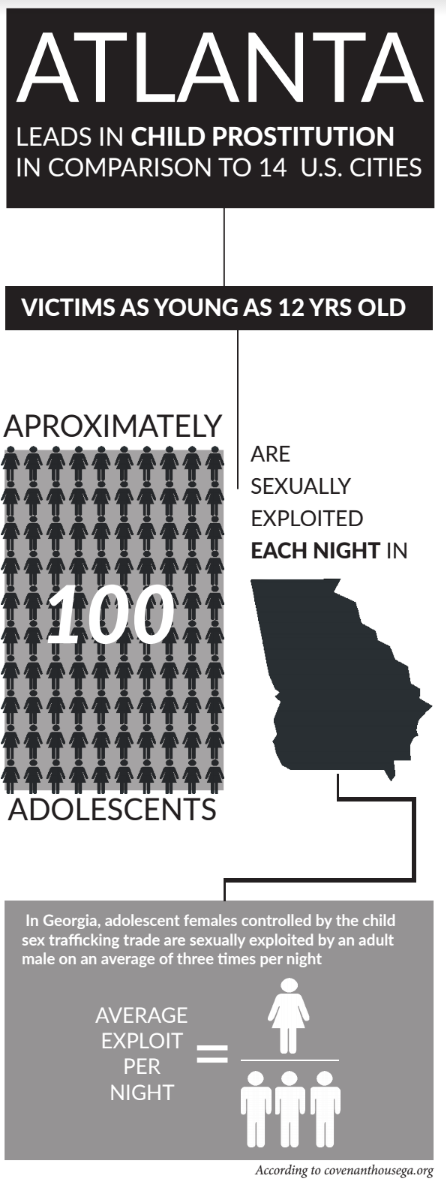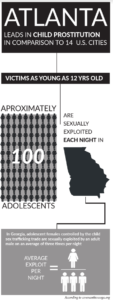

The state is locking down on sexual exploitation. Voters passed Amendment Two on the presidential election ballot, which proposed penalties be given to adult entertainment companies that encourage or host the sexual exploitation and assessments to child victims’ as services.
The penalty will be an annual $5,000 fee for adult entertainment businesses, which will be used to establish a Safe Harbor for Sexually Exploited Children Fund. This will provide rehabilitative and social services to children who have been sexually exploited. Other fines placed on convicted sex traffickers will also contribute to the supportive fund.
According to Children’s Healthcare of Atlanta, Atlanta is number one of 14 cities with the highest rate of child prostitution. In Georgia alone, 200-500 girls are exploited every month. Victims can be as young as 12 years old.
There are various initiatives on the rise to fight sexual assault and exploitation, one specific to Georgia State.
The university and the Georgia Center for Child Advocacy have partnered together for
Project Intersect, a program aiming to provide high quality care that can effectively serve the mental health needs of sexually exploited youth victims in Georgia.
The Georgia Center for Child Advocacy is a private, non-profit company providing outpatient therapy services to Atlanta’s youth who have been sexually exploited.
Shannon Self-Brown, a Georgia State Professor in the school of public health and Kelly Kinnish, clinical director at the Georgia Center of Child Advocacy, have already worked together to train over 100 therapists through Project Intersect. Self-Brown and Kinnish already partnered together on other projects when the opportunity arose to start Project Intersect.
But there are barriers to their movement.
Self-Brown told The Signal therapist must build a rapport so victims learn to trust the therapist and engage in the therapeutic process as a way to improve their overall mental health, otherwise, it’s almost impossible to get victims to open up.
The project trains therapists who work with agencies that experience and assist youth that have been sexually exploited here in Georgia. These adolescents will receive therapy that focuses on alleviating trauma.
Somatic Consequences of Violence Against Women, a scholarly article by Heslet L. Koss MP, says “Poor mental health is a dominant and persistent adverse health effect associated with human trafficking. Psychological consequences include depression; post-traumatic stress disorder and other anxiety disorders; thoughts of suicide; and somatic conditions including disabling physical pain or dysfunction.”
Youth victims of sex exploitation suffer from distinct complexities such as compelling educational setbacks, traumatic bonding and Stockholm syndrome, severe social and emotional challenges to normalization, and often disengagement from most or all family structure, according to the National Center for Homeless Education.
Project Intersect aims to help these youth recover from their victimization with a secure living environment, and seeks to access therapists working directly with the systems to offer care that can improve life for these youth.
The project has mostly encountered youth who have ran away from their home because of violence, neglect or a combination of both.
“Often, they are running away from very difficult situations in their home [such as] violence between the parents, violence between the parent and child, or more general neglect from the parents or caretakers who fail to appropriately supervise the child,” Self-Brown said.
She said, “We also know that in Georgia, youth who have a history of being in foster care, and youth who have experienced a significant loss, are at increased risk for being victims of sex trafficking.”
Research from Children’s Healthcare Atlanta states there are 1.6 million children who run away from their homes every year and of those children 1 in 3 are approached by a predictor within the first 2 days of being on the streets.
These professionals educate therapists who were interested in serving victims of sexual exploitation also know as Commerial Sexual Expoiled Children [CSEC] . Not all therapist know how to tackle the specific mental health needs of sexually exploited youth.
“It [Project Intersect] grew out of a need here in Georgia to keep pace with our improved identification of CSEC victims and also to provide training and support to therapists who were interested in serving trafficked youth but perhaps [they] were not sure how to best address their [CSEC] complex mental health needs,” said Kinnish.
Project Intersect utilizes a treatment that has been proven to reduce mental health symptoms. This treatment has shown to be effective with youth who experience traumatic events.
“The therapists work directly with the youth on psychoeducation, affect regulation, relaxation approaches, cognitive restructuring, and uses a technique called ‘gradual exposure’ to help the youth learn to talk about the traumatic events in a way that helps the youth feel empowered and less anxious and avoidant about thoughts and feelings related to the trauma,” said Self-Brown.
Project Intersect won a $2 million grant from the U.S. Department of Health and Human Services’ Substance Abuse and Mental Health Services Administration [SAMHSA] to continue their efforts started four years ago.
All funding from Project Intersect has come from the National Child Trauma Stress Network, which is part of Substance Abuse and Mental Health Services Administration. Project Interest has received two grants over the pass four years from this agency, totaling approximately $3.5 million.
The $2 million grant over the next five years will cover portions of salary for each team member, the costs for training therapists and will go to any costs related to understanding and serving the mental health needs of CSEC. Therapist are trained on caring for and understanding the trauma behavior of sexually exploited youth victims.
